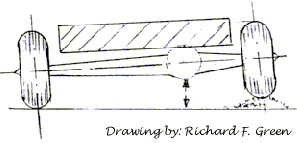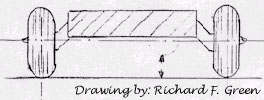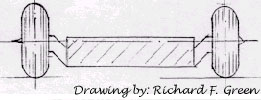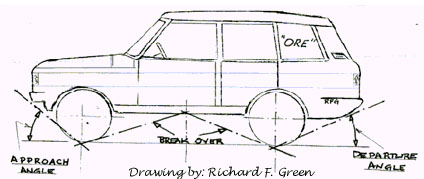|
Welcome to ORE! |
|
||
|
|
|||
|
|
|||

|
Above: "ORE" instructor Bret Morshead discusses the finer points of approach and departure angles, as well as break-over (shown here). Why don’t you join us for a day of fun and adventure? |
||||
| Off-Road Driving
Tips During every "ORE" Beginner class we have a short period set aside for what we call "classroom time", it is during this period that we discuss, among others things, the off-road driving tips listed here. These "tips" are proven material, and used by a number of companies throughout the world, including numerous 4WD manufacturers. Since you’ve read our web pages thus far, you must be ready to sign up for one of our classes, right? Hey, we even teach Camel Trophy participants and hopeful’s alike! How about you? Maybe you’ve read about "ORE" in one of a number of publications or saw us on KCRA-TV3. Yes? 1) Read your owners manual thoroughly before going off-road, or on road for that matter. Learn your vehicle. 2)
Never go
out alone as a short trip could be costly. Venturing off the highway alone
is never suggested. One canít foresee everything that could go wrong. Being
prepared yourself, having your vehicle prepared and maintained to a
reasonable degree will help counter some problems, but not all. A thought:
You're ten miles off the main paved road, your 4WD quits, you have an
accident, or someone is injured; Now what? 3) Always make sure your vehicle is prepared before departing. Read "Preparing & Maintaining". 4) Adopt a relaxed and upright driving position with a loose grip on the steering wheel, taking note to keep your thumbs out of the center section of the wheel, thus avoiding broken thumbs from steering wheel kick-back. This is a common problem on vehicles not equipped with power assisted steering. 5) Contact between your right foot and the gearbox tunnel will help increase throttle control. The use of a "dead-pedal" on the left is also helpful. DO NOT use the clutch pedal as a "dead -pedal". Once the clutch is engaged (out), keep your foot clear. 6) Know your
minimum ground clearance.
6A) On vehicles fitted with independent suspension however, the front wheels are attached to the A-arms which go up/down independently from each other, at the same time the center portion of the chassis/suspension goes up/down as well, though the exact opposite of the wheels. Type of terrain, as well as braking can effect your ground clearance dramatically; when the front wheels are bottomed on their suspension points (up in the fenders as far as they can go), your chassis and front suspension pivot points are now very vulnerable to damage as they come closer to the obstacle. It is a proven fact, that for heavy duty off-road work vehicles fitted with "live" axles are preferred.
As you can see from above, the ground clearance varies as the suspension moves up/down. Left: In its unloaded position you could have 8" (example), while Right: In its bottomed position it could reduce to half. Always be aware of vehicle ground clearance and obstacles. 7) Suspension &
Wheel Travel. 8) Know your "Approach angle", "Break-over" and "Departure angle" (Below). Knowing these figures (i.e.: Clearance), you’ll be able to negotiate obstacles much easier without damage to your vehicle. Interested in learning what these figures are on your vehicle? Try a long broom stick. Placing it under the edge of the tire, then lifting up until it makes contact with the body, you now have some idea of your angles. When off-road, drive up to your obstacle slowly, then stop get out and look to check clearances upon approach. When clearing the obstacle, be careful to "walk" the rear wheels off, remembering always that most 4WD vehicles have some sort of overhang beyond the rear axle (when "walking" your 4x4, the use of brakes, a spotter and your own sight will enable you to creep the rear wheels off the obstacle). Damage will result if care is not taken. As far as break-over is concerned, also know as "high-centered", this too will take a keen eye, the assistance of a spotter, and practice.
9) Know your vehicles height and width. Think about parking garages and parking spaces, will your 4WD clear the obstructions within the structure? Now apply the same to overhanging trees, narrow washes and rocks. Easy really. 10) Check the area(s) in which you plan to travel off-road. Ask locals about conditions. Purchase and review local maps. And... When in doubt, get out and take a brief walk to review the terrain ahead. This walk could save hours of digging and/or winching, or the anguish of having your new 4WD damaged. 11) Be aware of changing weather conditions, the last thing you want is to get caught on the desert floor. When in doubt head for high ground (when heavy rains come in), and get out of the washes or off the desert floors. Beware of fast running water... if you can’t swim it, don’t drive into it. Many vehicles have been lost in rough weather and water. Beware! 12) Know your Four-wheel-drive system. Unlike days gone by, the systems of today vary in their modes of operations and capabilities. Review your owners manual or talk with an expert concerning your vehicle make. Don’t assume anything. 13) Engage Low-Range before you need it. Choose the correct gear for the situation, see #12. Note: On vehicles fitted with a manual center "Diff-Lock", this should be disengaged once traction has been regained. However, Low-Range should be kept engaged until clear of the hazardous area(s). FYI: This center differential-lock is just that, a lock, locking the front & rear drive outputs of the transfercase together. When unlocked (disengaged) it will prevent "axle windup" with in the drivetrain. Vehicles fitted with a standard High-Low/2wd-4wd system have no center-differential, and when engaged in 4WD for long periods they will induce axle windup. You may notice that in tight turns while in 4WD that the front wheels will seem to hop and buck, this is the windup trying to escape from the system. Don’t be alarmed. 14) Before entering a difficult section, make your choice of gear selection. Remember that you should ALWAYS use lst gear (First, Low-Range) on down-hills for maximum engine braking effect, and keep the use of brakes to an absolute minimum, the use of which could cause sliding and loss of control. To correct a sliding vehicle, turn into the slide and apply some throttle, you will now have to straighten the steering wheel and let off the throttle. Gear selection for up-hill use depends on the make of vehicle, though 2nd or 3rd would be a good place to start. Choosing too high a gear can lug or stall an engine, keep you eye on the tach. Using steady rev’s of 1800-2200 rpm is a good starting point. 15) If conditions are soft (marshy ground, sand, etc.) it may be advisable to lower tire pressures. This helps improve traction, and will reduce sinking. Tires will have to be re-inflated for road use. |
||||
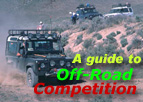


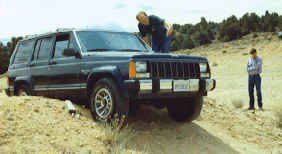 "a guide
to off-road driving". This policy has proved itself many times over, from the novice
first-timer, to those who call themselves "veteran off-roaders". Any number of
times per season we are asked to make acceptation to this policy, we’ve yet to budge,
and for good reason. Making the Beginner class mandatory we are able to meet all
participants under the same sort of conditions, thus enabling our instructors to get to
know you, what you want from the class, your abilities and those of your
vehicle (like people, most 4wd’s aren’t alike). Some tell us they are not
beginners... by days end (beginners class) these same people are singing a different tune,
the "veterans" telling us they learned things they didn’t know, whether
about their vehicle, its abilities, or their abilities. Did they enjoy their day? You bet!
Since we began operation, we are pleased to say that we have had not one complaint, all
responses have been positive. Ranger, Forest Service, Fire Fighter & Search-Rescue
classes available (with certificate).
"a guide
to off-road driving". This policy has proved itself many times over, from the novice
first-timer, to those who call themselves "veteran off-roaders". Any number of
times per season we are asked to make acceptation to this policy, we’ve yet to budge,
and for good reason. Making the Beginner class mandatory we are able to meet all
participants under the same sort of conditions, thus enabling our instructors to get to
know you, what you want from the class, your abilities and those of your
vehicle (like people, most 4wd’s aren’t alike). Some tell us they are not
beginners... by days end (beginners class) these same people are singing a different tune,
the "veterans" telling us they learned things they didn’t know, whether
about their vehicle, its abilities, or their abilities. Did they enjoy their day? You bet!
Since we began operation, we are pleased to say that we have had not one complaint, all
responses have been positive. Ranger, Forest Service, Fire Fighter & Search-Rescue
classes available (with certificate).